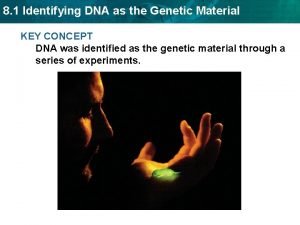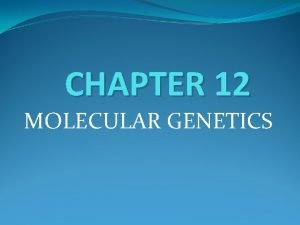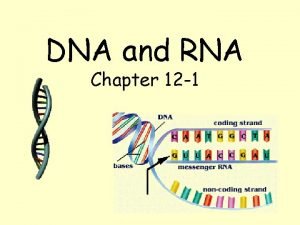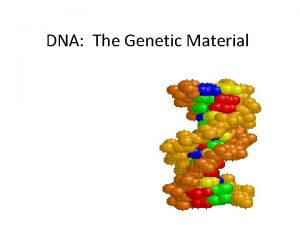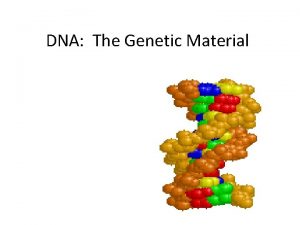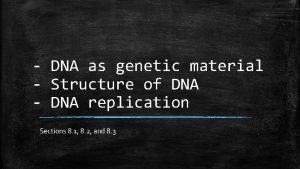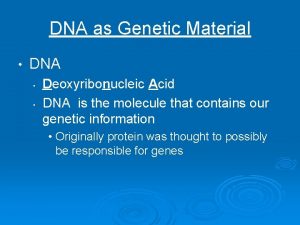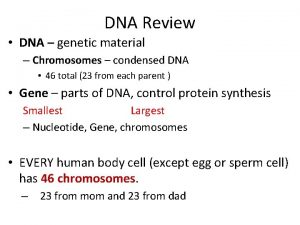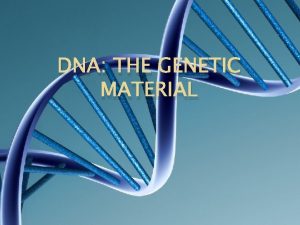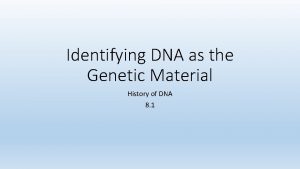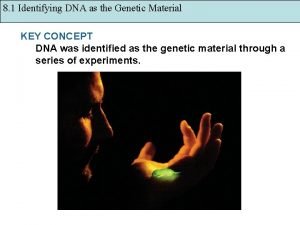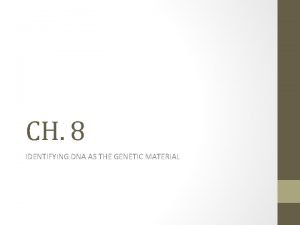DNA The Genetic Material Identifying the Genetic Material














- Slides: 14

DNA: The Genetic Material

Identifying the Genetic Material n Experiments of Griffith and Avery yielded results that suggested DNA was genetic material (1944)

n Hershey & Chase used the bacteriophage T 2 and radioactive labels to show that virus genes are made of DNA, not protein (1952)

n DNA stores information that tells cells which proteins to make and when to make them

The Structure of DNA n Discovered by Watson & Crick in 1953 & received Nobel Prize in 1962 along with Maurice Wilkins

n n n DNA Polymer : Nucleotide Monomer Each Nucleotide has 3 parts: 1) 5 carbon sugar Deoxyribose 2) Phosphate group PO 4 3) Nitrogen Base

Nitrogen Bases Purines Adenine Guanine Pyrimidines Thymine Cytosine


A T Human 30 30 Plant 27 27 Virus 21 22 n DNA forms a spiral ladder Double Helix n Double helix is held together by weak Hydrogen bonds n Erwin Chargaff Discovery Chargaff’s Rule A=T, G=C G 19 22 28 C 19 22 27

DNA Replication n n Phase of Cell Cycle? Why replicate? Step 1: DNA Helicase unzips DNA by breaking weak Hydrogen bonds. Step 2: DNA polymerase adds nucleotides to exposed nitrogen bases. Step 3: Two DNA molecules form that are identical to original.

n n DNA is referred to as “Semi-conservative”, Each DNA molecule 1 template & 1 new strand DNA polymerase proofreads DNA during its replication so that very few errors occur

n Eukaryotes


 Section 1 identifying dna as the genetic material
Section 1 identifying dna as the genetic material Section 12-1 dna
Section 12-1 dna Chapter 12 section 1: dna: the genetic material
Chapter 12 section 1: dna: the genetic material Section 12-1 dna
Section 12-1 dna Chapter 12 dna and rna section 12-1
Chapter 12 dna and rna section 12-1 Chapter 12 section 1 dna the genetic material
Chapter 12 section 1 dna the genetic material Identifying and non identifying adjective clauses
Identifying and non identifying adjective clauses Non identifying adjective clauses examples
Non identifying adjective clauses examples Identifying and non identifying adjective clauses
Identifying and non identifying adjective clauses A gene pool consists of
A gene pool consists of Genetic drift founder effect
Genetic drift founder effect Gene flow vs genetic drift
Gene flow vs genetic drift Genetic programming vs genetic algorithm
Genetic programming vs genetic algorithm Genetic programming vs genetic algorithm
Genetic programming vs genetic algorithm What role does dna polymerase play in copying dna?
What role does dna polymerase play in copying dna?
